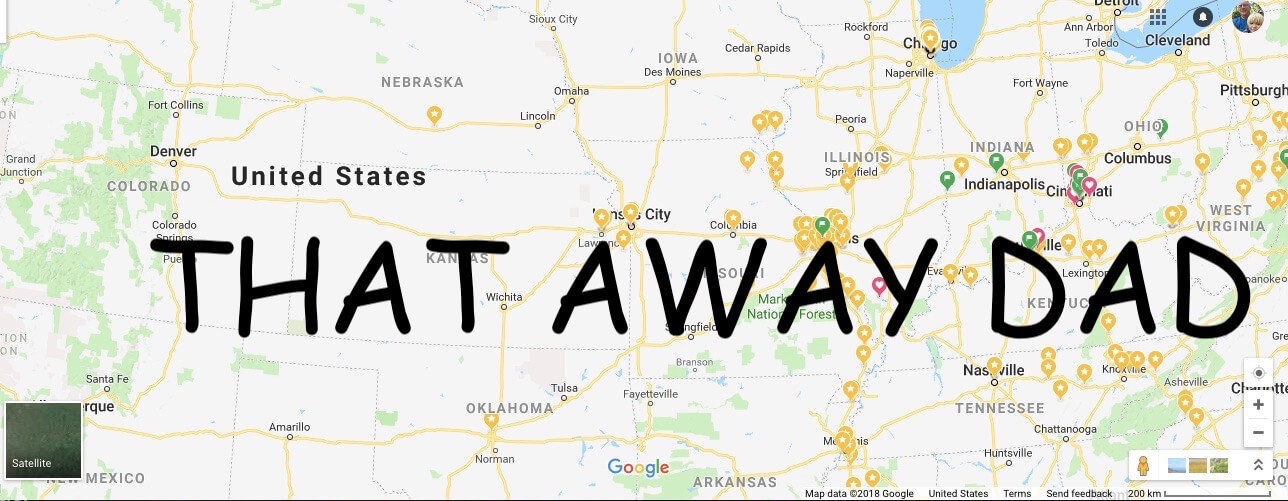Walking along a cliffside boardwalk high above Osage River highlights our time at Painted Rock Conservation Area.

The 1.6-mile Osage Bluff Scenic Trail also has an ancient Native American burial cairn and a small cave to discover.
History
Painted Rock State Conservation Area’s namesake is rock paintings done between 1200 and 1300 A.D. and seen by explorer Zebulon Pike in 1806, although not accessible by the trails here.
The Native American burial cairn along the hike is much older between 500-1500 years old. Built for a great chief, legends say. At one time these burial cairns were numerous in the counties along the Osage and Gasconade Rivers. Brought up to areas of high elevation, heaps of stones were created out of respect for a final resting place for these leaders.
Our Time At Painted Rock
Starting Out
We headed to the right on the loop trail, which took us to the Native American cairn first.

This part of the hike was mostly level. We pass by a grouping of limbs that made a lean-to.

My son Andrew found a long-fallen tree trunk to balance on. He likes finding these along the trail and seeing how well he can go across them.

Rock Cairn
We stop at the burial cairn behind a wooden fence. I wonder what chief was honored here.

Bloody Island Overlook
Down from the cairn was an overlook with views of the Osage River. North of the overlook is Bloody Island known for a legendary treasure.
One story is that a Spaniard was heading back from making his fortune in gold out west to his love in St. Louis. He had a run-in with Native Americans. He escaped and buried his gold to retrieve it later. Yet, he faced them once more and was killed and treasure still lies buried there. Andrew was fascinated by this story.

Finding a Cave
Before the trail headed away from the cliffside, there is a short trail to a small narrow cave that you can look into. Up from there, my son noticed more holes and a narrow rock shelter before it drops off.

Leaving the River Walk
Walking away from the river we head along a rock outcropping. The rock here was deposited over 400 million years ago as fine ocean sediment from an ancient sea. Chert from the rock was once used to form arrowheads.

In the Woods
We walked towards a bridge that crossed Cove Creek that held small pools of water. The trail now went into switchbacks up the hillside heading back to the river.

Osage Bend Overlook
We step onto a boardwalk by a steep cliff leading to the overlook.

Here you stand on top of a 140-foot cliff. Upstream you can see how the river is cutting into the hillside creating the Osage Bend.

Gnarled by wind, snow, and ice, an Eastern red cedar tree by the edge of the deck is dated to be over 600 years old.

Heading Back
The walk from here includes expansive views of the river since the overlook was at a high point on the hillside. This was a scenic walk before it finally turns back towards the trailhead.

Final Thoughts on Painted Rock Conservation Area
I enjoyed this hike that included high river views near rock outcroppings over the green Osage River.

The views include valleys with cows or horses in the fields. Old barns hug hills across the river. I would like to go back in the spring to see wildflowers bloom or maybe in the fall, the area blazed in color. Along with the scenic walk, this area has a fascinating past.

NOTE: A booklet provided by the Missouri Conservation Area near the parking lot in a wooden box gives information on the conservation area’s geography and history.

DETAILS:
Drive: This conservation area is located about halfway between the Lake of the Ozarks and Jefferson City and a little over two hours away from the St. Louis metro area. Take Interstate 44 to US-50 West toward Jefferson City. Use the left lane to take the US-63 S exit toward Rolla. Turn right onto MO-133 N off of US-63 and look for parking for the conservation area on your right.
Hours: 4 am – 10 pm
Address: Westphalia, MO 65085
Nearby Hikes
See Castle Ruins at Ha Ha Tonka State Park

Castle ruins on a cliff above Lake of the Ozarks, a natural bridge, and a clear spring are some of the treasures at Ha Ha Tonka State Park.
Hiking here you will come across many manmade and natural wonders.
Hiking the Shores of Lake of the Ozarks State Park

Blaze a trail below cliffs with water views along with plenty of hikes and activities to choose from at Lake of the Ozarks State Park.
More Native American Sites
Finding Petroglyphs at Washington State Park

A visit to Washington State Park includes ancient Native American petroglyphs, a cave, and historic stone overlooks along Big River. It is about an hour south of St. Louis.
Piney Creek Ravine Nature Preserve

Find the largest area of Native American Rock art in Illinois at Piney Creek Ravine Nature Preserve.
This 198-acre nature preserve also has cascading waterfalls and colorful limestone cliffs.


